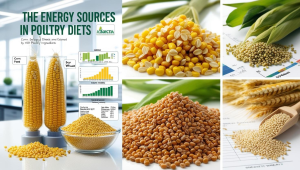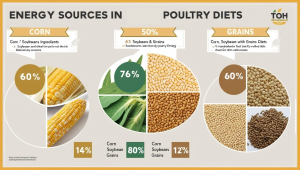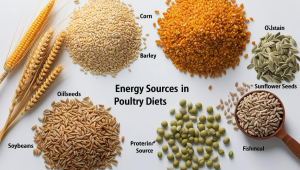Energy is one of the most critical components in poultry nutrition, influencing growth, reproduction, egg production, and overall performance. Poultry require energy to sustain bodily functions, maintain body temperature, and perform activities such as feeding, walking, and laying eggs. The primary sources of energy in poultry diets are carbohydrates, fats, and, to a lesser extent, proteins.
This article explores different energy sources in poultry diets, their significance, factors affecting energy utilization, and how to optimize energy levels for improved poultry productivity.
Click HERE to join our WhatsApp group
Importance of Energy in Poultry Nutrition
Energy plays a fundamental role in:
Growth and Development – Energy fuels metabolic processes and muscle growth in broilers.
Egg Production – Adequate energy is necessary for optimum egg-laying performance in layers.
Feed Efficiency – Proper energy levels help achieve the best feed conversion ratio (FCR).
Health and Immunity – Birds with sufficient energy intake develop stronger immune responses.
Reproduction – Breeders require energy for egg fertility and hatchability.
READ ALSO: Dairy Farming: Best Practices for High Milk Yield
A well-balanced poultry diet should meet the energy demands of the birds at different growth stages while avoiding deficiencies or excesses that may lead to metabolic disorders.
Main Energy Sources in Poultry Diets

Energy in poultry feed comes mainly from carbohydrates, fats, and proteins. However, the major contributors are carbohydrates and fats, as proteins are mainly used for tissue formation rather than energy.
a) Carbohydrates
Carbohydrates are the primary and most economical energy source in poultry diets. They are derived from cereal grains and by-products.
Common Carbohydrate Sources in Poultry Diets:
Corn (Maize) – Highly digestible and widely used due to its high energy content and palatability.
Wheat – Contains less energy than corn but is rich in digestible starch.
Sorghum – An excellent substitute for maize, though some varieties contain tannins that reduce digestibility.
Barley – Moderate energy content but contains β-glucans, which can interfere with digestion.
Rice Bran – Contains fiber and moderate energy but should be used carefully due to rancidity risks.
Cassava (Tapioca) – A cheaper energy alternative, but requires processing to remove anti-nutritional factors.
READ ALSO: Parasites in Livestock and Poultry: Identification and Control
b) Fats and Oils
Fats and oils are concentrated energy sources, providing 2.25 times more energy than carbohydrates. They also improve feed palatability and aid in the absorption of fat-soluble vitamins (A, D, E, and K).
Common Fat Sources in Poultry Diets:
Animal Fats – Tallow, lard, and poultry fat provide high energy but may become rancid if not stored properly.
Vegetable Oils – Soybean oil, palm oil, sunflower oil, and canola oil are commonly used.
By-Product Fats – Used cooking oils and grease from food processing industries can be economical but require proper refining.
c) Proteins as an Energy Source
While proteins primarily serve as building blocks for muscle, organs, and enzymes, they can also provide energy when carbohydrates and fats are insufficient. However, using proteins for energy is inefficient and costly.
Protein-Rich Energy Sources:
Soybean meal
Fish meal
Meat and bone meal
Distillers dried grains with solubles (DDGS)
Since protein is an expensive nutrient, poultry diets are formulated to prioritize carbohydrates and fats for energy, reserving proteins for growth and tissue repair.
Factors Affecting Energy Utilization in Poultry

Several factors influence how efficiently poultry utilize energy from feed:
a) Bird Age and Growth Stage
Young chicks require highly digestible energy sources as their digestive systems are not fully developed.
Broilers need high-energy diets for rapid growth, whereas layers require moderate energy to sustain egg production without excessive weight gain.
READ ALSO: Behaviour differences linked to broiler growth rates
b) Feed Processing and Particle Size
Grinding and pelleting improve digestibility and energy utilization.
Finely ground grains enhance nutrient absorption but may cause digestive issues such as gizzard erosion.
c) Fiber Content
High-fiber ingredients (e.g., rice bran, wheat bran) dilute energy content and reduce digestibility.
Enzyme supplementation (e.g., xylanase, cellulase) can enhance fiber breakdown and improve energy extraction.
d) Fat Quality and Stability
Rancid fats reduce energy value and can harm bird health.
Antioxidants like Vitamin E and synthetic stabilizers are added to prevent fat oxidation.
e) Energy-to-Protein Ratio
A balanced energy-to-protein ratio ensures efficient nutrient utilization.
Excess energy relative to protein can lead to fat deposition rather than lean growth.
Energy Requirements in Different Poultry Categories

Each poultry type has specific energy needs:
a) Broilers (Meat Production)
Require high-energy diets for rapid weight gain.
Energy levels range from 3000-3200 kcal/kg of feed.
b) Layers (Egg Production)
Moderate energy intake to sustain laying without excess fat accumulation.
Energy levels range from 2700-2800 kcal/kg of feed.
c) Breeders (Reproduction)
Balanced energy for egg fertility and hatchability.
Requires 2600-2900 kcal/kg of feed.
READ ALSO: Vaccination and Disease Prevention Strategies
Strategies for Optimizing Energy Use in Poultry Diets
To maximize energy utilization, poultry farmers and nutritionists should:
Use High-Quality Grains – Avoid contaminated or mold-infested grains.
Incorporate Fat Sources Strategically – Blend vegetable oils with animal fats for balanced nutrition.
Enhance Digestibility with Enzymes – Enzyme supplementation improves energy extraction from fibrous ingredients.
Monitor Feed Intake and Adjust Diets Accordingly – Different breeds and environmental conditions affect energy needs.
Prevent Feed Spoilage – Store fats and grains properly to avoid nutrient losses.
Future Trends in Poultry Energy Nutrition
The poultry industry continues to evolve with new energy innovations:
Alternative Energy Sources: Algae, insect meal, and fermented feed offer sustainable energy solutions.
Precision Nutrition: Advanced feed formulations using AI and big data optimize energy intake.
Nutrigenomics: Genetic research is improving feed efficiency at the DNA level.
Conclusion
Energy is the foundation of poultry nutrition, influencing growth, production, and efficiency. A well-balanced diet should include a mix of carbohydrates, fats, and minimal protein for energy, ensuring optimal poultry health and productivity. By understanding energy sources and optimizing feed formulations, farmers can enhance flock performance, reduce feed costs, and improve profitability. With ongoing research and innovation, poultry nutrition will continue to advance, ensuring sustainable and efficient poultry production.
READ ALSO: Calcium and Other Nutrients for Egg-Laying Hens
Egg production is a nutrient-intensive process that requires a well-balanced diet to ensure optimal hen health and productivity. Among the various nutrients needed, calcium plays a critical role in eggshell formation, bone health, and overall well-being of laying hens. However, calcium alone is not sufficient—other essential nutrients, including proteins, vitamins, and minerals, must also be supplied to maintain peak egg production and prevent health complications…
READ ALSO: Contagious Caprine Pleuropneumonia in Goats
Contagious Caprine Pleuropneumonia (CCPP) is a highly infectious respiratory disease that affects goats and is caused by the bacterium Mycoplasma capricolum subsp. capripneumoniae (Mccp). It is considered one of the most economically significant diseases in goat farming, leading to high morbidity and mortality rates in affected herds. CCPP is a transboundary animal disease that poses a serious threat to goat populations, particularly in Africa, Asia, and parts of Europe and the Middle East…
Click HERE to join our WhatsApp group

